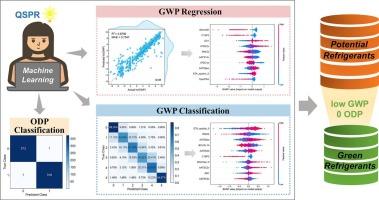基于机器学习的全球变暖和制冷剂臭氧消耗潜力预测
IF 4.3
2区 工程技术
Q2 ENGINEERING, CHEMICAL
引用次数: 0
摘要
全球变暖潜能值(GWP)和臭氧消耗潜能值(ODP)是制冷剂的关键环境指标,但目前还缺乏准确的预测方法。通过收集最先进的GWP和ODP分子数据库,本研究引入了考虑多种机器学习算法的QSPR模型,以执行GWP回归、GWP分类和ODP分类的需求驱动任务。通过严格的验证方案,确定了每个任务的最佳模型,在测试集上的R2为0.8790,分类精度为0.6890,分类精度为0.9971。然后,对最优模型进行SHAP分析,以更深入地了解各个特征的贡献。最后,对最终模型进行高通量筛选,以确定潜在的绿色制冷剂。这项工作为预测制冷剂的环境特性和支持制冷剂系统的设计提供了可靠的工具。本文章由计算机程序翻译,如有差异,请以英文原文为准。

Machine learning-based prediction of global warming and ozone depletion potentials of refrigerants
Global warming potential (GWP) and ozone depletion potential (ODP) are pivotal environmental metrics of refrigerants, whereas accurate predictive methods for predicting GWP and ODP are still scarce. By collecting the state-of-the-art molecular GWP and ODP database, this study introduces QSPR models considering diverse machine learning algorithms to perform the demand-driven tasks of GWP regression, GWP classification, and ODP classification. Through a rigorous validation scheme, the best models are identified for each task, which achieve an R2 of 0.8790, a classification accuracy of 0.6890, and a classification accuracy of 0.9971 on the test sets, respectively. Following that, SHAP analysis is performed for the optimal models to gain deeper insights into the contributions of individual features. Finally, a high-throughput screening with the final models is conducted to identify potential green refrigerants. This work provides a reliable tool for predicting the environmental properties of refrigerants and supporting the design of refrigerant systems.
求助全文
通过发布文献求助,成功后即可免费获取论文全文。
去求助
来源期刊

Chemical Engineering Science
工程技术-工程:化工
CiteScore
7.50
自引率
8.50%
发文量
1025
审稿时长
50 days
期刊介绍:
Chemical engineering enables the transformation of natural resources and energy into useful products for society. It draws on and applies natural sciences, mathematics and economics, and has developed fundamental engineering science that underpins the discipline.
Chemical Engineering Science (CES) has been publishing papers on the fundamentals of chemical engineering since 1951. CES is the platform where the most significant advances in the discipline have ever since been published. Chemical Engineering Science has accompanied and sustained chemical engineering through its development into the vibrant and broad scientific discipline it is today.
 求助内容:
求助内容: 应助结果提醒方式:
应助结果提醒方式:


